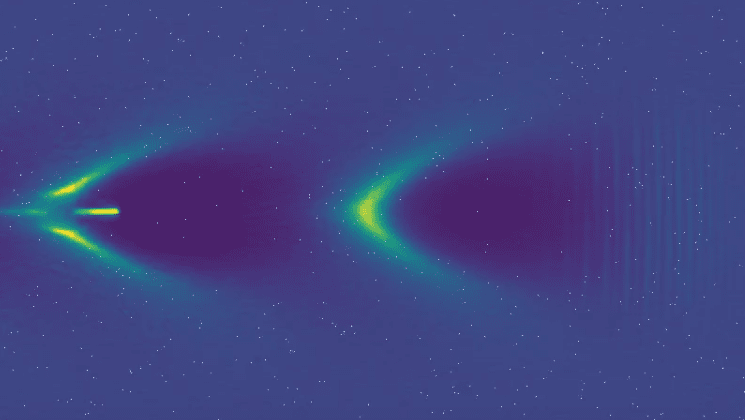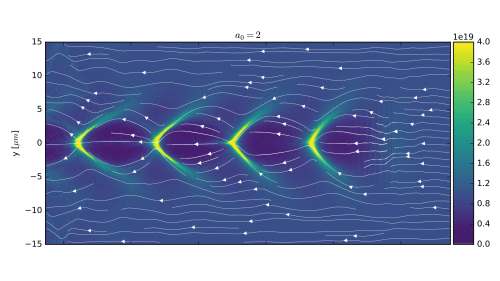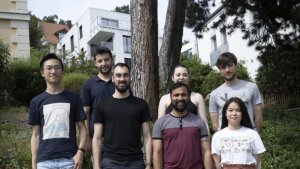
This video shows a simulation of a relativistic laser pulse propagating through a plasma. The plasma density is modulated due to the plasma wake driven by the laser pulse. The imprint of the laser's electric and magnetic filed is still visbile in the front. The while lines visualize traces of inidiviual particles of the plasma. The length of each line corresponds to the position of the particle during the last 5.5 femto seconds. Therefore faster particles have longer lines. Video by Stephan Kuschel.
Grafik: FreepikLaser erzeugen die extremsten Felder, die im Labor auf mesoskopischen und makroskopischen räumlichen Skalen erreichbar sind (nur hochionisierte Schwerionen haben höhere Felder, aber nur über Längen von Angström). Ultraintensive Laser erreichen Felder von 1013 V/m und mehr, oder in verschiedenen Einheiten betragen diese Felder 10 MV/µm oder 10 GV/mm. Teilchenbeschleuniger, die Hochfrequenzwellen verwenden, beschleunigen Teilchen typischerweise über Entfernungen von vielen Metern bis Kilometern auf MeV bis GeV – was den Einsatz von Laserfeldern sehr attraktiv macht.
Die Elektronenbeschleunigung ist am effizientesten, wenn ein Beschleunigungsfeld sich gemeinsam mit den Elektronen über große Entfernungen bewegen kann. Dies wird erreicht, indem mit einem leistungsstarken Laser eine Kielwasserwelle (wie die Welle, die einem Schiff folgt) angetrieben wird: Der Laser stößt die Elektronen auf seinem Weg aus (genau wie ein Schiff das Wasser wegstößt) und die Elektronen spüren eine Kraft, die sie beschleunigt. Die Abbildungen zeigen Simulationen der Plasmawelle ohne und mit beschleunigtem Elektronenbündel (das beschleunigende Bündel ist der Punkt in V-Form).
Das Forschungsteam des Zielbereichs 1
Foto: Ira WinklerPublications:
- v. Grafenstein, K., Foerster, F.M., Haberstroh, F. et al. Laser-accelerated electron beams at 1 GeV using optically-induced shock injectionExterner Link. Sci Rep 13, 11680 (2023).
- B. Lei, T. Teter, J. W. Wang, et al., "Flexible x-ray source with tunable polarization and orbital angular momentum from Hermite-Gaussian laser modes driven plasma channel wakefieldExterner Link," Phys. Rev. Accel. Beams 22 071302, (2019)
- S. Kuschel, M. B. Schwab, M. Yeung, D. Hollatz, A. Seidel et al., "Controlling the Self-Injection Threshold in Laser Wakefield Accelerators"Externer Link, Phys. Rev. Lett. 121 (15), 154801, (2018)
- B. Lei, J. Wang, V. Kharin, M. Zepf et al., "gamma-Ray Generation from Plasma Wakefield Resonant Wiggler"Externer Link, Phys. Rev. Lett. 120 (13), 134801, (2018)
- J. W. Wang, C. B. Schroeder, R. Li, M. Zepf et al., "Plasma channel undulator excited by high-order laser modes"Externer Link, Sci. Rep. 7, 16884, (2017)
- M. Yeung, S. Rykovanov, J. Bierbach, L. Li et al., "Experimental observation of attosecond control over relativistic electron bunches with two-colour fields"Externer Link, Nat. Photonics 11 (1), (2017)
- S. Kuschel, D. Hollatz, T. Heinemann, O. Karger et al., "Demonstration of passive plasma lensing of a laser wakefield accelerated electron bunch"Externer Link, Phys. Rev. Accel. 19 (7), 071301, (2016)

